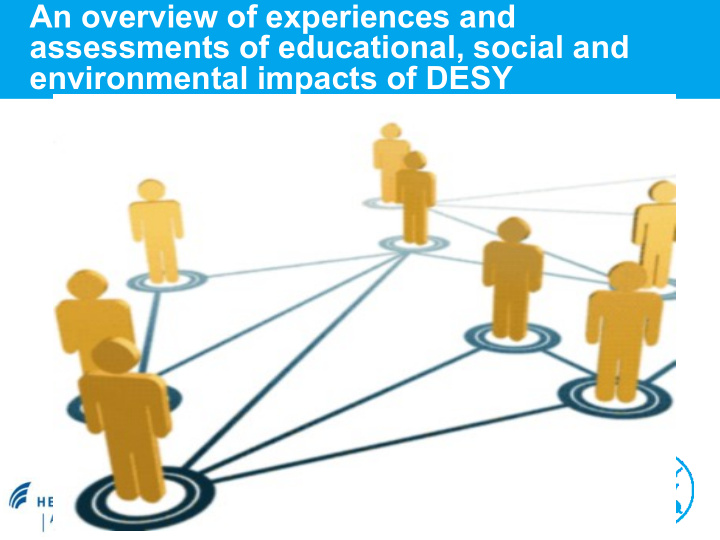



An overview of experiences and assessments of educational, social and environmental impacts of DESY
Education & Human capital at DESY in 2010 Supply of skilled graduates and researchers > Training: 120 apprenticeships > 93 diploma students (57 from german universities and research facilities and 36 from foreign institutions) > 300 PhDs (196 /104) > 358 Postdocs (213 /145) > Totally DESY is involved in the education of 751 young scientists per year > 99 students from all over the world taking part in the summer student programm for 8 weeks > 7900 pupils visiting DESY in Hamburg and Zeuthen in the context of „Physik begreifen “
Education OPAL (Partical Physics Experiment at CERN) > New graduates entering industry bring with them Knowledge of recent scientific research The skills needed to perform research and develop new ideas Skills in using advanced instrumentation and techniques The ability to solve complex problems > No DESY statistics where Graduates are leaving to, but the OPAL experiment could give a hint for graduates in High Energy Physics (1983-2004) Applying this allocations to HERA (1992-2007) with ~1000 PhD graduates => More than 500 graduates entered industry
Social Capital > Social capital is broadly defined as the institutions, relationships, attitudes, and values that govern interactions among people and contribute to economic and social development (Grootaert and van Bastelaert, 2002) Readiness to give one another access to their networks Trust is created and principle of reciprocity is reinvorced Greater overlap in knowledge increasing the efficiency of knowledge transfer > There is no linear process of innovation - Interactive nature of learning process characterises innovation > Economic benefits are difficult to measure > Research infrastructures provide an entry point into networks of expertise and practice > Small body of literature dealing with social impacts of RIs DESY No. of business cooperation in 2010: 26 DESY No. of scientific cooperation in 2010: 414 + suppliers, funding organisations, goverment bodies, civil societies ,…
Example of Social Capital impact: Industry‘s benefits from TTF/FLASH Benefits for their own business Stated by 83 suppliers (1992-2004) of DESY‘s FLASH facility 23 % Educational Gain Educational Gain 38 % Major innovations Major innovations 46 % Additional investments Additional investments Sales of new products to other customers Sales of new products to other customers 53 % Influence on whole portfolio of products Influence on whole portfolio of products 60 % 82 % DESY as important reference customer DESY as important reference customer
International nature of DESY Guest Scientists & Users ~ 3,000/year from over 45 nations In 2007 at Hasylab: German Users: 1045 Internat. Users: 757 No. Of Nations: 35
Example of social capital impact: Mobility & Innovation > Research institutions and host countries benefit from inflow of human capital through in-migration of foreign scientists Different educational background and origin may complement each other Knowledge exchange stimulatse diversity and creativity leading to innovative and creative ideas > Assumption that mobile scientists possess broader skills and social capital that are conducive for entrepreneurship > According to study using a sample of approximately 2500 researchers from Max Planck Society foreign-born scientists (non German citizens) and foreign educated scientists (German scientists with PhD degree from foreign universities) are more likely to become entrepreneurs.
Science@DESY is energy intensive Facilities at DESY have power input 24 MW Annual consumption of 200 GWh mainly provided by fossil sources Releasing roughly 110 kt CO2 per year ~ energy consumption of german city with 50 000 inhabitants Laboratories (bio/chem/phys) Universities ~300 kWh/(m 2 a) ~150 kWh/(m 2 a) Future developments of energy prices? Residential area How climate neutral/sustainable should research centres be? ~40 kWh/(m 2 a) => Strategic question of energy supply
RIs as a stimulating environment for technical and structural innovations Better Energy management for facilities Existing energy consumption data only on a high aggregated level First step: set up an energy management controlling system According to the main findings of workshop on „ Energy management for large-scale research infrastructures “ in Lund 2011 RIs should make use of their human and social capital in regards to energy management > Training on young researchers, operators and managers > Exchange of best practices > win/win partnerships with industries > Supporting renewable energy through new and improved materials, environmentally biofuels, new and safe methods od carbon capture, tc.
Conclusions Education & Human Capital > RIs play important role in capacity building. Added value is found mainly quality of the training provided. Social Capital > Need for better understanding about the impact of social capital of RIs > Key Performance Indicators and measurements of Social Capital needed > Positive relationship between career mobility and the propensity to engage in academic entrepreneurship Environmental Impact > Regarding the environment energy-intensive research infrastructures have a negative socio-economic impact , but… > High potential to find innovative energy management solutions
Recommend
More recommend